Like a blast from the past, eh? It feels like its been a year since the last time we saw one of these. And, well, you’re right — the last one was published in December of last year. Sorry, I’m lazy. But without further stalling on my part, let’s get to the results . . .
Well, actually, a teensy bit more stalling first for the methodology.
As I explained in the first post we did about ammunition consistency testing, we’re using the velocity of the rounds as the sole metric for determining the “accuracy” of the ammunition. And as I explain every time, the reason is that velocity is the only metric that can’t be influenced by the shooter or the equipment (assuming the equipment stays the same). And by measuring the spread in velocity for the rounds, it will give us an idea of how far the ammo will spread vertically downrange. Thus, velocity is the One True Factor that we test.
What does that mean for the average Joe? LOW = GOOD.
It’s worth noting at this point that our (my) methodology for ammunition consistency testing has been adopted by more than one ammunition manufacturing company after seeing the results. Which either confirms my methodology, or just means that the manufacturers are lazy. It could be a little of both. Or neither. Anyway . . .
On tap for today are the 300 Blackout offerings of Remington. From left to right are the subsonic 220 grain variety, the 115 grain supersonic “standard” UMC loads and finally, the 125 grain Premier AccuTip match grade loads.
Looking just at the outside of the cartridges, the UMC looks absolutely awful. I mean, its dark, its dirty and there are stray marks from the bullet seating machines on the bullets themselves (which can’t help accuracy). Which would explain why they’re roughly half the price of the Premier rounds. But are you really getting half the accuracy?
Here’s the regular boxplot. I know, not very helpful at first glance. But when you realize that the match ammo is about 10 grains heavier and yet is still being pushed out of the barrel faster than the UMC loads, it starts to make you wonder how much more velocity you can get out of the 115s. Moving on . . .
Ah, the normalized boxplot; always so very informative about which ammo really is the most consistent. And this time is no different, with the UMC clearly . . .
I mean, the Premier ammo clearly . . .
Huh, looks like its too close to call from just the plots. But what’s for sure is that we have a new leader on our charts for the most consistent factory load for 300 BLK ammo. So let’s wheel out that bar graph showing the interquartile range for the recorded velocities, shall we?
Looks like its a tie between UMC and Premier match grade ammo for the top spot, both clocking in at a whopping 7 fps smaller IQR than CMMG. Remington subsonics come in just on the other side of CMMG, still slightly more consistent than PNW match grade ammo.
It figures that Remington, owners of Advanced Armament Corp – the original producers of 300 AAC Blackout – would have the best loads. But will they retain their spot? Or will Wilson combat swoop in and grab the title like they did for 5.56 ammo? Stay tuned.
| Brand and Weight | Caliber | IQR | $/round |
| Remington UMC 115gr | .300 BLK | 20 | $0.52 |
| Remington AccuTip Premier 125gr | .300 BLK | 20 | $1.39 |
| CMMG 147gr | .300 BLK | 26 | $0.78 |
| Remington Subsonic 220gr | .300 BLK | 27 | $0.92 |
| PNW M 155gr | .300 BLK | 28 | $0.90 |
| PNW D 220gr | .300 BLK | 54 | $1.08 |
| Brand and Weight | Caliber | IQR | $/round |
| Wilson Combat 77gr Sierra HPBT Match |
.223 Rem | 19 | $1.52 |
| Wilson Combat 65gr Sierra SP BT |
.223 Rem | 21 | $1.52 |
| Hornady 75gr BTHP Match |
.223 Rem | 29 | $0.79 |
| CorBon 69gr HPBT |
.223 Rem | 30 | $1.18 |
| Remington Premier Match 77gr BTHP |
.223 Rem | 36 | $1.50 |
| Winchester 64gr “Power Point” SP |
.223 Rem | 38 | $0.82 |
| Wolf 55gr FMJ |
.223 Rem | 40 | $0.21 |
| Federal XM193F 55gr FMJ |
.223 Rem | 40 | $0.32 |
| Pierce 55gr HP-BT |
.223 Rem | 42 | $?.?? |
| Nosler Varmint 40gr Ballistic Tip |
.223 Rem | 44 | $0.86 |
| Handloads – 20.8gr N-135 75gr Hornady HPBT Match |
.223 Rem | 49 | $?.?? |
| Handloads – 21gr IMR 3031 75gr Hornady HPBT Match |
.223 Rem | 52 | $?.?? |
| Winchester PDX-1 60gr SC-HP |
.223 Rem | 58 | $1.45 |
| American Eagle 55gr FMJ-BT |
.223 Rem | 68 | $0.30 |
| Brand and Weight | Caliber | IQR | $/round |
| Hornady Superformance Match 150gr SST |
.308 Win | 26 | $1.21 |
| Wilson Combat 168gr Sierra HPBT Match |
.308 Win | 28 | $1.99 |
| PMC Bronze 147gr FMJ BT |
.308 Win | 39 | $0.50 |
| SetPoint – 44gr Varget 150gr Hornady FMJ BT |
.308 Win | 52 | $1.74 |
| Prvi Partizan 150gr FMJ |
.308 Win | 54 | $0.82 |
| Remington “Managed Recoil” 125gr CORE-LOKT PSP |
.308 Win | 125 | $1.40 |

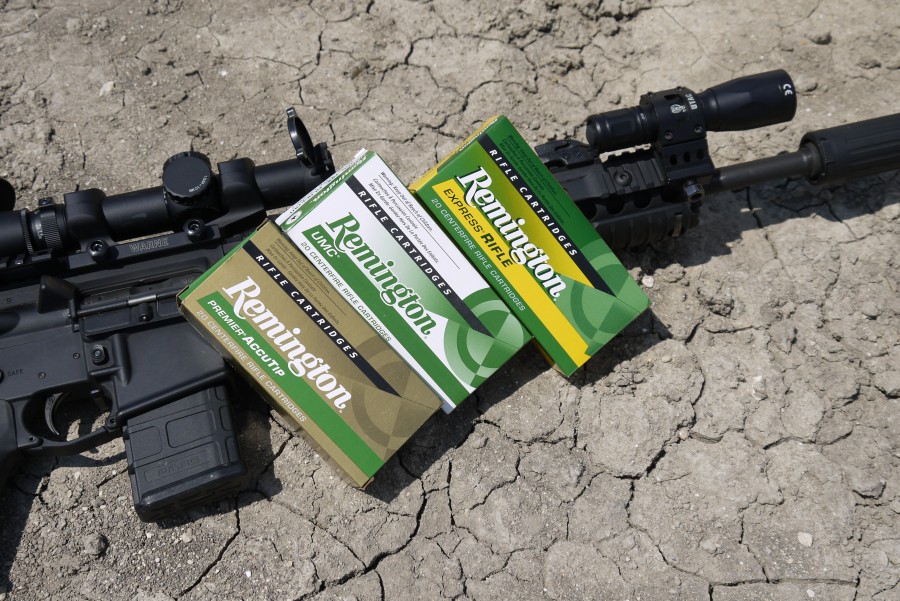
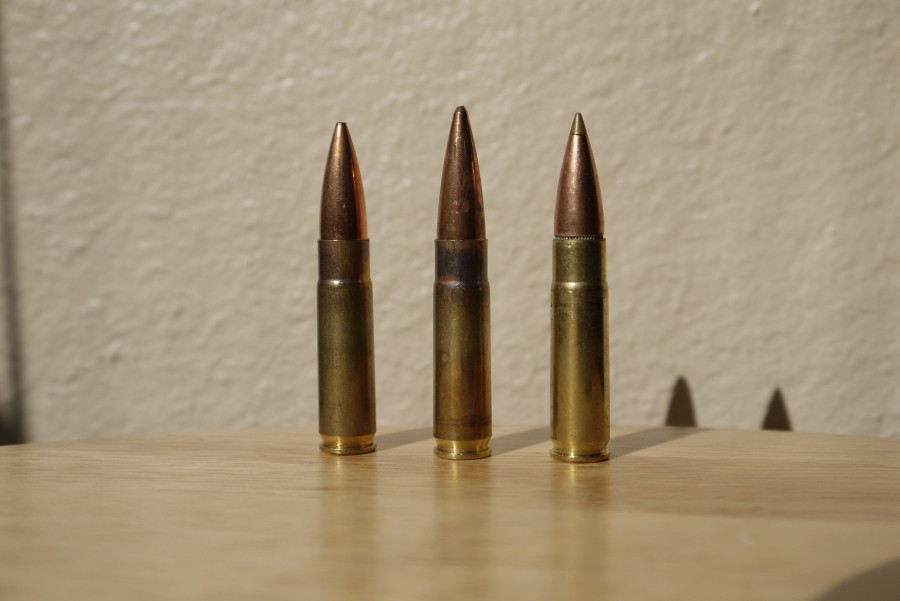
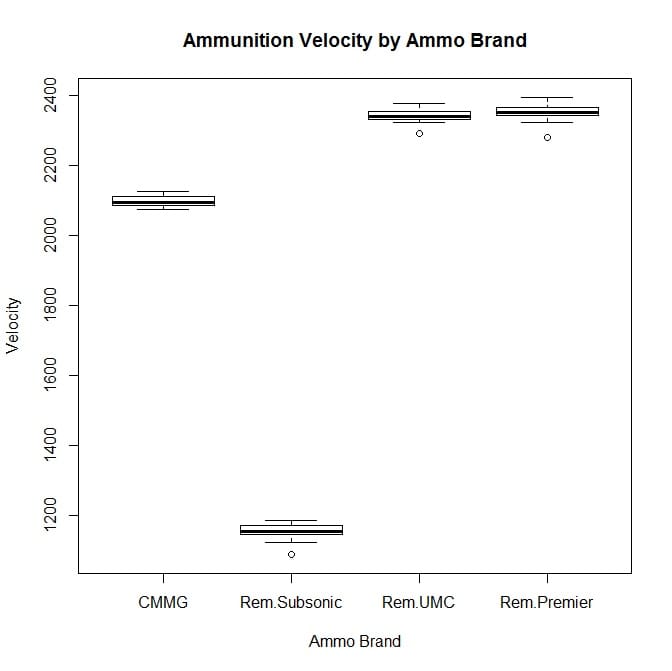
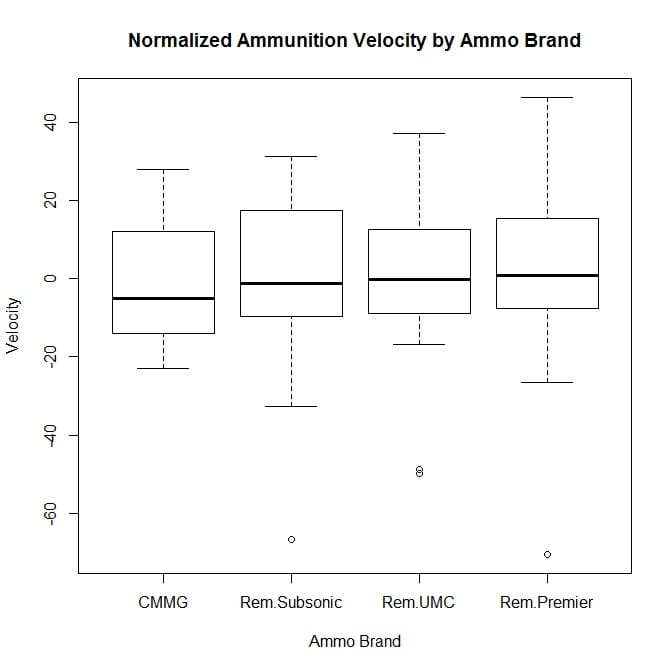
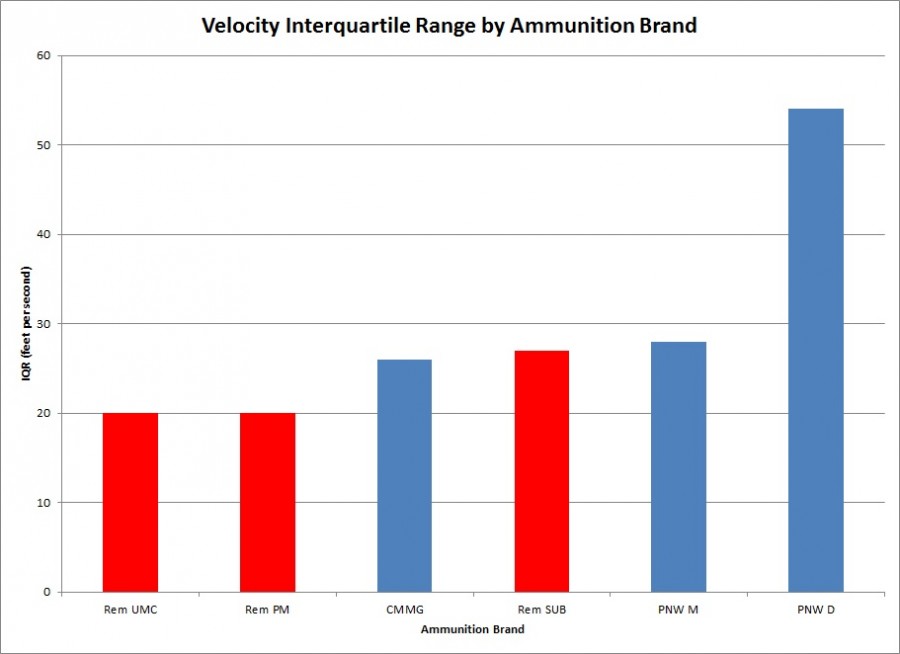



Speaking of stalling…polymer mag torture test?
I’m really, really impressed at the consistency of the UMC considering the significantly lower price than anything else tested. It’s nice to know that “cheap range ammo” doesn’t have to mean “junk range ammo.”
You can never tell. At 100 yds, my M21 shoots 150 gr Power Points just as well if not a little better than Wilson or Federal match. But my Fulton AR-10 hates the stuff. Same barrel length,same twist, chambers mic’ almost identical.
Curious about the plots you’re putting up on TTAG these days. I noticed them in this article and in the recap from the reader’s survey. What are you using to generate them?
Bar graphs and pie charts I do in good ol’ Microsoft Excel, but the boxplots and mathematical analysis I like to do in R instead.
Just curious, thanks. I use matplotlib a lot at work for visualizing lots of large data sets mainly because I like python
Just started tinkering around with Processing because it seems to be easier and have more documentation available.
Velocity variation means little without group sizes. Sometimes ammo with more velocity variation can be more accurate than ammo with less velocity variation.
An ammunition test should tell us how accurate the ammunition is.
But how do you do that in a controllable manner? How do you completely remove the weapon and the shooter from the equation? There will always be some error thrown into the mix that will keep the group sizes from being as perfect as possible no matter how you do it. Velocity is the only way to really be sure, since physics tells us that the consistency of the velocity WILL directly correlate to the vertical spread of the group downrange. Unless you have a magic rifle that senses how fast bullets are going and adjusts on the fly…
Skynet.
While this is a good basic comparo that beats the hell out of “what is says on the side of the box”, I am curious what corrections, if any you made to correct your data points.
Atmospherically speaking, for the sake of short-range velocity testing humidity is of negligible effect, so we can eliminate that. But ambient air temp and barometric pressure can have a good deal of influence over the velocity of a bullet as well as the burn rate of the powder in the shell.
If the ambient temp changes 10C during the course of a day-long shoot that can produce a velocity change of 25FPS (.308Win). Did you correct for ambient?
Assuming you used only one gun, which rounds were fired in what order? Did you do a batch of one brand(AAAAA), then a batch of the next (BBBBB) or was it (ABCDABCD).
Barrel temperature and fouling will have a some impact on velocity of the bullet down the pipe. Not much, but 5 or 6 FPS per effect can compound error rather quickly when looking at a narrow spread like 40 FPS. Beyond that, what’s the accuracy of the chrono used?
Just curious, because while the data presentation seems well laid-out, we are talking about unit spreads of only 40-ish FPS. As such, the other relevant factors have to be accounted for somehow. In other words, the math looks great, but if the underlying data isn’t corrected, frankly it’s kinda meaningless.
Bullet concentricity prior to loading, seating depth, overall cartridge weight and length, perhaps? Good, consistent ammo is about more than velocity. Then there’s just good old fashioned trial and error – if it works well in a gun that’s set up properly and shoots tiny groups then you obviously have a good gun / cartridge combo.
I’ve never considered Remington UMC to be “cheap” ammo. My Ruger 556, Glock 27, Smith 4006, and Glock 35 definitely like it. Then again, I’ve never shot it over 100 yards.
I appreciate your article and your data – it’s good to see hard velocity numbers.
Your also starting to make me want a 300 AAC upper…
Nick makes a good point here that may be lost on some. There is no way to tell how accurate xyz-brand ammo will be in your gun without testing xyz-brand ammo in your gun. Chamber dimensions, leade, barrel length and twist, barrel material, and manufacturing tolerances will all muck with a cartridge’s supposed “inherent accuracy”. Simply put: there is no such thing as “inherent accuracy”. The only measurable statistic for factory ammo is velocity. Okay, sure, Nick could pull bullets and get and average and std-dev for bullet weight. He could measure OAL and report avg/std-dev, although for domestically-produced ammo this should be negligible. As far as concentricity of the jacket (abnormalities of which will cause the bullet to wobble in flight) or consistency of powder burn-time (fluctuations of which could cause fluctuations in bullet acceleration whilst traversing the barrel), we’re in the dark. Therefore the velocity stats he reports are the best-available metric of a particular load’s potential ability to hit the same spot every time.
The hand loader cooking up match loads could certainly measure those things in the quest for an “inherently accurate” load. I’m not about to judge premium match ammo solely on deviation of velocity. Realistically, Nick’s velocity deviation test are objective, quantifiable, and useful. I’m just pontificating about the limitations of the data, not trying to be difficult. The proof is in obviously the impacts on target, groups sizes, etc. within a particular firearm and a specified range. I’m also not discounting the effects of a high ballistic coefficient in mitigating the effects of wind drift and velocity loss – particular at extended ranges.
Accur81: Agree with all you said. My post was more in response to Dean, above. Sorry if we got mixed up.
I admit that it is difficult to rule out variations in firearms and in shooters. I appreciate your data, but if you are going to the trouble of shooting the ammo, I would like to see group sizes.
Yes, it would be best done in an indoor range with perfect conditions, a match rifle and a well practiced shooter.
However, I think an ordinary competent shooter in decent conditions can still tell us quite a bit.
Thank you for the information. It still took a lot of work, which I appeciate. I was too short in my comment. What I was trying to communicate was that I wanted to see what this ammunition could do for groups. Even a rough measure would tell us something.
Sorry of I came off as too critical. Thanks for putting in all the work that you do.
I just got done with my first range session with my new Smith and Wesson m&p15 in .300 AAC blackout. I absolutely loved it, and I suffered 0 issues with the 200 rounds of Remington UMC I put through it. That gun’s more accurate than I am at 100 yards, and it will definitely be my go to deer rifle this fall.
I know it’s in the 223 part of the table but I’m surprised the hand loads are so variable.
That would be me sucking at handloading. I’ve gotten marginally better since then, but I’m nowhere near the Masters.
Being a noncognozcenti, would you kindly explain what we are supposed to gather from that last bar graph? Even the title of the graph means nothing to me.
Lower numbers = more consistent velocities. Consistency leads to accuracy.
I tried posting this up a bit more elegantly earlier, but it seems to have disappeared into the ether…
The charts are nice and the conclusions are rather clear to read, but there’s some unanswered questions in the methodology.
1. As ambient temp is a significant factor in post-muzzle velocity, how did you correct for it?
2. As ambient temp has a significant effect on burn rate of powder, how did yo correct for it?
If you start in the morning and finish in the afternoon, that 10+ degree change will have an impact on speed.
2.As barometric pressure is a significant factor in velocity, how did you correct between rounds, or was it stable all day?
3. Although in short tests (5 rounds-ish) barrel temps not been shown to have a huge impact it has some (5ishFPS). Fouling also has an impact. Did you clean between batches?
4. Most telling (as it would tend to self correct for some of the aforementioned issues) in what order did you test? That is to say Brand AAAAA, Brand BBBBB, Brand CCCCC or was it ABCABCABC?
5. Also what is the accuracy of the chrono?
You may have done all those corrections and if you did, thanks for a thorough test. But, as your not listing anything about the methodology or posting the raw data, one has to ask. Especially when one is dealing with spreads of under 40FPS per round, those details can turn into major compound errors in short order.
Comments are closed.